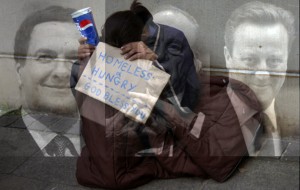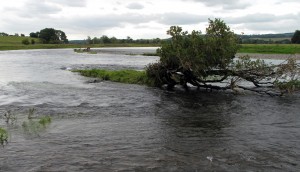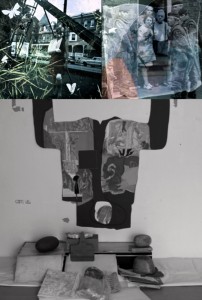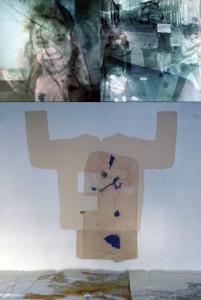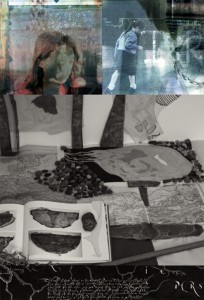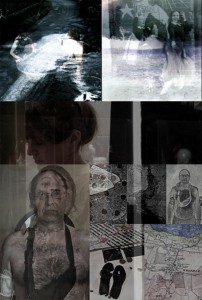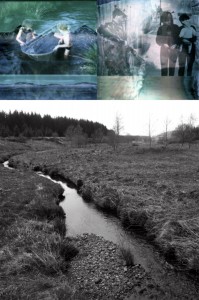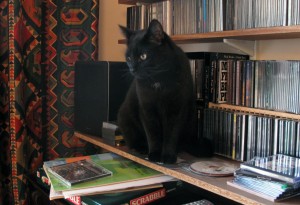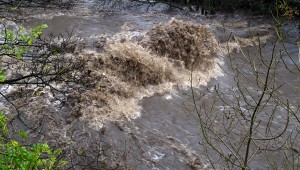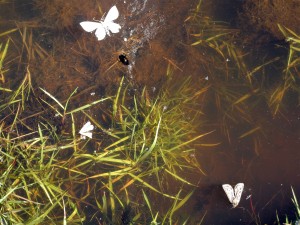
7. Imaginal convergences (an evocative swerve)
(The essay of which this is the second part swerves slightly at this point).
I need to introduce the thinking of James Hillman and, more particularly, its possible convergence with Owain’s paper already quoted. (From where I stand Owain’s thinking is – at least potentially and as it relates to Guattari’s transversality – ‘fighting talk’). This swerve is closely related to a concern with the most academically neglected of Felix Guattari’s ‘three ecologies’ – the embattled ecology of a self, now inevitably located in relation to a culture of possessive individualism, but here specifically seen as more or less enmeshed in the professional worlds of the arts and academia.
Peaks and Vales, a talk given by the depth psychologist James Hillman and first published in 1996, helps place the frame of my cognitive dissonance in a ‘watery’ context. Hillman is concerned with distinctions between a ‘placed’ or ‘grounded’ imaging or imaginative thinking (vales), and what I’m going to call, following the feminist philosopher Geraldine Finn, ‘high altitude thinking’, which she defines as thinking: “forgetful of its contingent roots in particular persons, places, and times” (1996: 137) (peaks). I am going to suggest that this definition is also broadly analogous, at the level of praxis, to a distinction Owain makes between ‘grand theory’ and ‘small acts of intervention’ (2008: 1609).
Hillman wants to discriminate between high-altitude thought and low-lying, intra-psychic understanding; one happy to acknowledge its own contingencies and that “requires recognition of history, an archaeology of soul, a digging in ruins, a re-collecting”. (The parallels with deep mapping are clear here). ‘Vales’ are located by Hillman in such a way that “going up the mountain” – the privileging of high-altitude or ‘peak’ thinking as the authoritative, all-seeing mode of thought – “feels like a desertion” (1979: 62). (An observation that goes a long way to explain the very real anger many lay people feel when subjected to academic high theory). He goes on to elucidate the resonances of the word ‘vale’; ‘the vale of tears’, of emotion (even depression – the “lonesome valley, the valley of the shadow of death”), and so on. (ibid: 58).
The affective resonances of ‘vale’ have a great deal to do with water, with its always draining down to the lowest point, the resulting ‘swampy-ness’ (literal and metaphorical), with ebb and flow; with psychotherapeutic work analogous to ‘sewage treatment’, to the processing of the mess and muddiness of everyday life – its ”troubles, sorrow, and weeping”. Also, again, with water’s ‘sensuous matter’, its “sensuousness and depth”, its evoking dreams and delusions, to touch the Oceanic so as to animate our caring for the world “for better or worse”. All of which may well requires that ‘the Word’ of high altitude thinking be brought down to participate in its other, “in gossip and chatter” (ibid. 67).
Is this maybe relevant to new methods and methodologies in a ‘watery’ context?
Hillman asks that we address the increasingly stultifying legacy of a secularised binary system grounded in monotheism’s “verticalities of the spirit” (ibid: 68), in Deleuze and Guattari’s ‘arboreal thinking’. Unlike them, however, Hillman asks us to moisten the dryness of ‘vertical thinking’ rather than simply reject it, to bring it “down from the mountain … into the vale” (ibid: 69); to wade it out and down into the complexities of swampy, estuarine multiplicities, to submerge it there until it’s awash with the fluid paradoxes and ambiguous subjectivities of the everyday world as polyverse.
In short, from the ‘watery’ perspective I’m foregrounding here, our ‘academic distance’, ‘critical reflexivity’, and ‘objectivity’ all appear as something close to ‘desertion’, a retreat to the high ground away from the mycelial tangle of mangrove roots (which enable those trees to live in the liminal zone shared by both salt and fresh water), from the mess of everyday life awash with cognitive dissonances.
This might suggest that we should attend to the re-hydration of high-altitude thinking by immersing in everyday ‘depths’, in ‘Vales’.
- Second ‘provocation’: combative collaboration (the value of ‘hatred’) and moving on
James Hillman also reminds us that: “part of separating and drawing apart is the emotion of hatred” (not, of course, to be taken too literally), and I share something of his concern with: “speaking with hatred and urging strife, or eris or polemos, which Heraclitus, the first ancestor of psychology, has said is the father of all” (ibid: 57-8).
To clarify, I think it’s important to promote what, in the ‘Hard’ Sciences, is sometimes called ‘combative collaboration’, since genuine collaboration is constructively combative, energized by recognising and openly working through (again in both senses) differences and dissonances, rather than with assumed or imposed consensus. I see this approach to collaboration as a means to overcome the way we get stuck, fail to move on, continue to assume that it’s acceptable to internalize and work from, for example, the presuppositions of ‘life-as’ an ‘artist’, ‘social scientist’, or whatever.
As I’ve discussed at length elsewhere, we still struggle to acknowledge what the immunologist and poet Miroslav Holub argued so eloquently back in 1990. Namely that a preoccupation with the differences between the arts and sciences is a dangerous indulgence that we can no any longer afford because it blinds us to more important issues, not least the realities of power (2014: 47-8).
As the introductory quotation from Owain Jones implies, our epistemological crisis flows from a refusal to acknowledge that ecosystems in all registers are (almost always) open. They require a continual flow, flux, or translation of energy and matter across the semi-permeable borders that differentiate one discipline, bioregion, society, or persona (within the inter-subjective constellation of any self), from another. This is not of course to imply that we should now simply prioritise an amorphous fluidity over all requirements to differentiate. Early in his essay Holub usefully distinguishes, for example, the work of the scientist from that of the poet in terms of distinct framings of types of imaginative process. He argues that scientists must always assume the adequacy, however temporary, of their means; while artists must on the whole work with the “immanent inadequacy” of theirs (1990: 132).
Again, I think this may have methodological implications for what we’re trying to do.
That both modes of creativity can, in different circumstances, transversally ‘cut across’ meta-disciplinary boundaries supports Holub’s contention that it is ultimately unhelpful to place too much emphasis on the distinctions between the work of the artist (poet) and the social scientist (scientist) that he makes in the first part of his text. He goes on in the second part to relativize these distinctions, not least because he understands monolithic identification with ‘life as’ an ‘artist’ or a ‘scientist’ as unrealistic, even deluded. In actuality both ‘artists’ and ‘scientists’ spend considerable periods of time engaged in a multiplicity of other roles and actions unconnected to those activities. (Which is to say they inhabit, in the terms used here, an inclusive polyverse). Furthermore Holub observes that the work (verb) of science or art is, in actuality, located within a small, subtle, largely confined if at times pervasive, domain with regard to society as a whole and, as such, requires that we attend as much to their multiplicity of relations – to Hillman’s ‘Vale’ if you will – as to their exclusivity. In Holub’s view conventional disciplinary and professional understandings that fail to acknowledge this situation promote hubristic, exclusive, and cultish preoccupations and distort or marginalize more fundamental concerns in ways that facilitate the abuse of power by ever more powerful systems of management and manipulation.
- Third ‘provocation’: listening and citizenship
In the light of both Holub’s concerns indicated above and the insights of Heelas and Woodhead, I think it’s relevant to our project that currently orthodox evaluations of research in the Arts and Humanities has been shown to bear “no relation to how innovation and creativity occur” (Leach & Watson 2010: 7). Leach and Watson argue that the real value of such research lies in its being: “carried by and in persons” as “expertise, as confidence, as understanding and orientation to issues, problems, concerns and opportunities, as tools and abilities”; and that it is best seen as residing in “the notion of responsiveness” (ibid: 7). A responsiveness that supports and authorises those same qualities in others, and calls for a privileging of listening over speaking to which I will return later. All of which is best understood as the conversational “aspect of citizenship” that privileges those “spaces and opportunities for discussion, argument, critique, reflection’ in which “collaboration” becomes a basis “for evaluation” (ibid: 3).
I relate these observations directly to exchanges with staff from the Yorkshire Water Board, who were clearly consciously negotiating their own cognitive dissonances around managerially imposed responsibilities and expectations on one hand and a place-specific ‘becoming’ on the other. Our conversations, particularly informally over lunch, were for me a high point of the two-day event. They validated Leach and Watson’s observations and support Owain’s suggestion that we privilege “small acts of intervention” based on listening.
The importance of listening in this respect is set out by Gemma Corradi Fiumara in her The Other Side of Language: A Philosophy of Listening (1990), and relates to Holub’s concern that we be constantly mindful of the sites and dynamics of power. In this context I would stress her insights into: “the mechanism of ‘saying without listening’”, seen as having finally constituted itself as “a generalized form of domination and control” (1990:2); a situation she addresses in terms borrowed from Lakoff and Johnson and that highlights the nature of the metaphorical power embedded in language – in, for example, our concern to ‘win’ arguments as if they were wars (ibid: 108). Again, I take this to square with Owain’s insistence that we need to replace “established adversarial styles of academic argument with ‘a model of dialogical encounter’”, one predicated on the assumption that “the other has something to say to us and to contribute to our understanding” (Jones 2008: 1607) Consequently I would argue that Fiumara’s insights relate directly to our concerns with hydro-citizenship for reasons the following observation makes clear.
“To the extent that we cultivate an awareness of belonging to the biological history of the planet we might be able to develop the sort of openness that allows us to reconnect our biological and dialogical dimensions. Whenever our phylogenetic depth [I think here of Hillman’s ‘vale’] is not taken into sufficient account as an inseparable aspect of the human condition we are restricted to an ‘abstract’ sort of philosophical knowledge that does not measure up to the task of encompassing our own biological nature”(ibid. 184).
And that ‘nature’ is, it should not be necessary to say, where we are most intimately inseparable from all ‘watery matters’.
Again, I would link this, in terms of method, to Owain’s stressing (with Harrison 2002: 500), that his readers “‘to pay attention to whatever is taking place in front of them’”, an orientation that: “can be understood as a call to witness … to share and deeply empathize with pain and suffering – the negative (although it could be applied to joy and love) – the positive) and otherness, without fully knowing it”. And, in relation to research in the service of high-altitude thinking again, “Pause to think how often it is that understandings of and responses to current/historical events are not prompted by explanations or analysis but by witnessing of one kind or another” (Jones 2008: 1610).
Bibliography
Biggs, Iain (2014) ‘Beyond Aestheticism and Scientism: Notes towards an “ecosophical” praxis’ in Brett Wilson, Barbara Hawkins, and Stuart Sim (eds) Art, Science, and Cultural Understanding Champaign, Illinois: Common Ground
(2012) “The Southdean Project – essaying site as memory work” in Jones, Owain & Garde-Hansen, Joanne (eds.) Geography and Memory: Explorations in identity, place and becoming Basingstoke, Palgrave MacMillan.
(2010) ‘Essaying Place: Landscape, Music, and Memory (after Janet Wolff)’ in Johns-Putra, Adeline & Brace, Catherine (eds.) Process: Landscape and Text (Amsterdam & New York, Rodopi
Bishop, Claire (2013) Artificial Hells: Participatory Art and the Politics of Spectatorship London & New York: Verso.
Casey, Edward S. (1993) Getting Back into Place: Towards a Renewed Understanding of the Place-World Bloomington & Indianapolis: Indiana University Press.
Drucker, Joanna (2005) Sweet Dreams: Contemporary Art and Complicity Chicago, University of Chicago Press
Finn, Geraldine (1996) Why Althusser Killed His Wife: Essays on Discourse and Violence Atlantic Highlands: Humanities Press International.
Fiumara, Gemma Corradi (1990) The Other Side of Language: A Philosophy of Listening London: Routledge.
Gibbons, Michael; Limoges, Camille; Nowotney, Helga; Schwartzman, Simon; Scott, Peter; and Trow, Martin (1994) The New Production of Knowledge: The Dynamics of Science and Research in Contemporary Societies London SAGE Piublications.
Guattari, Felix. (2008) ‘The Three Ecologies’ in Pindar, Iain & Sutton, Paul (trans) Guattari: The Three Ecologies London & New York: Continuum.
Heelas, Paul and Woodhead, Linda (2005) The Spiritual Revolution: why religion is giving way to spirituality Oxford: Blackwell
Hillman, James (1976) ‘Peaks and Vales’ in Puer Papers on line at: http://www.jungboulder.org/peaks-and-vales.html
Holub, Miroslav (1990) The Dimensions of the Present and Other Essays (ed. Young, D) London: Faber.
Illich, Ivan et al, (2010) Disabling Professions (London: Marion Boyers)
Jones, Owain (2008) Stepping from the wreckage: Geography, pragmatism and anti-representational theory Geoforum, 39 (4). pp. 1600-1612.
Leach, James (2012) ‘Constituting aesthetics and utility: copyright, patent, and the purification of knowledge objects in an art and science collaboration’ in HAU: Journal of Ethnographic Theory 2: (1): 247-268
(2011) ‘The Self of the Scientist, Material for the Artist: Emerging Distinctions in an Interdisciplinary Collaboration’ in Social Analysis vol 55:3, Winter 2011, pp. 143-163
Leach, James & Watson, Lee (2010) Enabling innovation: creative investments in arts and humanities research http://www.jamesleach.net/articles.html (accessed 30.03.2013).
Marris, Peter (1978) Loss and Change (revised ed) London & New York: Routledge.
Napier, A David (2003) The Age of Immunology: conceiving a future in an alienating world Chicago & London: University of Chicago Press
Platten, Bronwyn & Biggs, Iain (2014) ‘Engagement and Embodiment: A Body of Art in Healthcare’ in Wilson, Brett; Hawkins, Barbara, and Sim, Stuart, (eds) Art, Science, and Cultural Understanding Champaign, Illinois: Common Ground
Whatmore, Sarah J. & Landström, Catharina (2011) Flood apprentices: an exercise in making things public, Economy and Society, 40:4, 582-610,
Wilson, Brett; Hawkins, Barbara, & Sim, Stuart (eds.) (2014) Art, Science, and Cultural Understanding Champaign, Illinois: Common Ground
